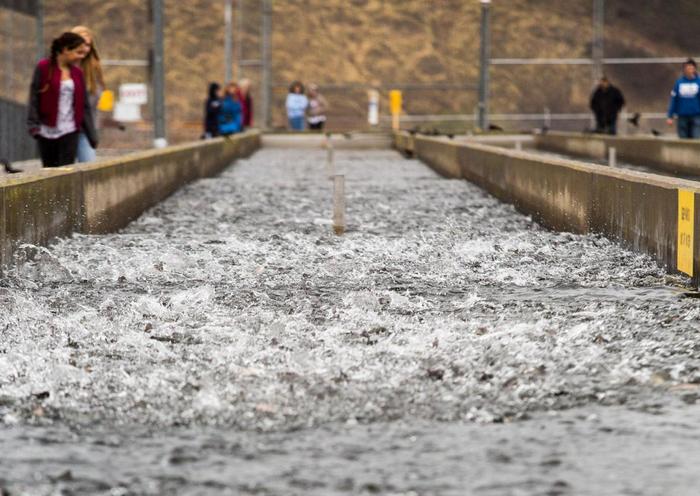Accident kills thousands of hatchery trout

Accident kills thousands of hatchery trout
September 9, 2015
Sacramento Bee
An estimated 155,000 rainbow trout suffocated in a matter of minutes Tuesday at the American River Hatchery near Rancho Cordova due to an unexpected release of gunk from Folsom Dam that clogged water intakes.
The unexpected die-off could mean anglers have a tougher time finding fish to catch next year, since the 4-inch Eagle Lake subspecies of rainbow trout were to be released when they grew larger, said Bill Cox, hatchery system manager at the Department of Fish and Wildlife, which also operates the adjacent Nimbus Hatchery for salmon.
State hatchery managers already were struggling amid a disease outbreak and California’s historic four-year drought to keep enough fish in lakes and rivers to satisfy their legal obligations to supply fish for the state’s nearly 2 million recreational anglers.
“We already had less inventory than we wanted for this hatchery,” Cox said. “Now, if we lose those fish, that’s a big hit. Now, we’re going to have to figure out what we’re going to do about it.”
Cox said the die-off at the American River Hatchery occurred without warning Tuesday afternoon. He said he’s not exactly sure what happened, but he knows that the Bureau of Reclamation, which manages Folsom Dam, “changed to a pipe they hadn’t use in several years” as part of a dredging operation.
“And when they did that, a slug of stuff ... came down and came into the hatchery,” he said.
Trout require cold water to survive, so the hatchery has a sophisticated cooling and filtration system that chills the water flowing into the hatchery tanks and holding ponds. The gunk clogged the system, in essence shutting off the water flow – and oxygen supply – for the tightly packed fish.
Tanks holding 250,000 Eagle Lake trout were the hardest hit. Cox estimated that as many as 200,000 of them suffocated Tuesday. On Wednesday, the department determined that the number was closer to 155,000. Hundreds of another type of rainbow also died.
We already had less inventory than we wanted for this hatchery Now, if we lose those fish, that’s a big hit. Now, we’re going to have to figure out what we’re going to do about it.
Shane Hunt, a spokesman for the federal agency, said Tuesday that he hadn’t yet heard about the die-off, so he couldn’t comment.
The Department of Fish and Wildlife is bound by state law to stock ample fish in the state’s rivers and lakes to keep recreational anglers happy. These anglers’ license fees help fund the hatchery system and the department as a whole.
Last year, the state sold 1.78 million fishing licenses.
Trout are among the most popular fish to catch in California, and tanker trucks, typically filled with half-pound rainbows, remain a common sight coming and going from reservoirs. For decades, the agency also has used airplanes and even pack mules to dump hatchery-bred trout into high mountain lakes and streams where tanker trucks can't go.
Trout stocking days are celebrated by many anglers, because they can mean easily attained bag limits of the hatchery fish that gobble down bait more aggressively than more wily native fish. The state posts detailed stocking schedules online, and many newspapers publish them.
But, much as the drought has affected spawning streams for native, wild fish, it also has taken a toll on the state’s trout-stocking program.
In 2008, the agency stocked 4.3 million pounds of trout. This year, it was down to 1.6 million pounds – and the fish being planted are smaller than normal.
Fearing that low water levels and oppressive heat would lead to catastrophic losses of some trout, hatchery officials stocked many lakes and streams earlier than normal this year, while waterways were still cool. That means the fish had less time to mature.
Instead of half-pounders, many of the fish released this year were half that size.
Earlier this year, the department also quarantined 3 million trout at two north state hatcheries because of an outbreak of whirling disease.
All told, the quarantine was equal to about 15 percent of the trout stocks at state hatcheries.

Website Hosting and Design provided by TECK.net
